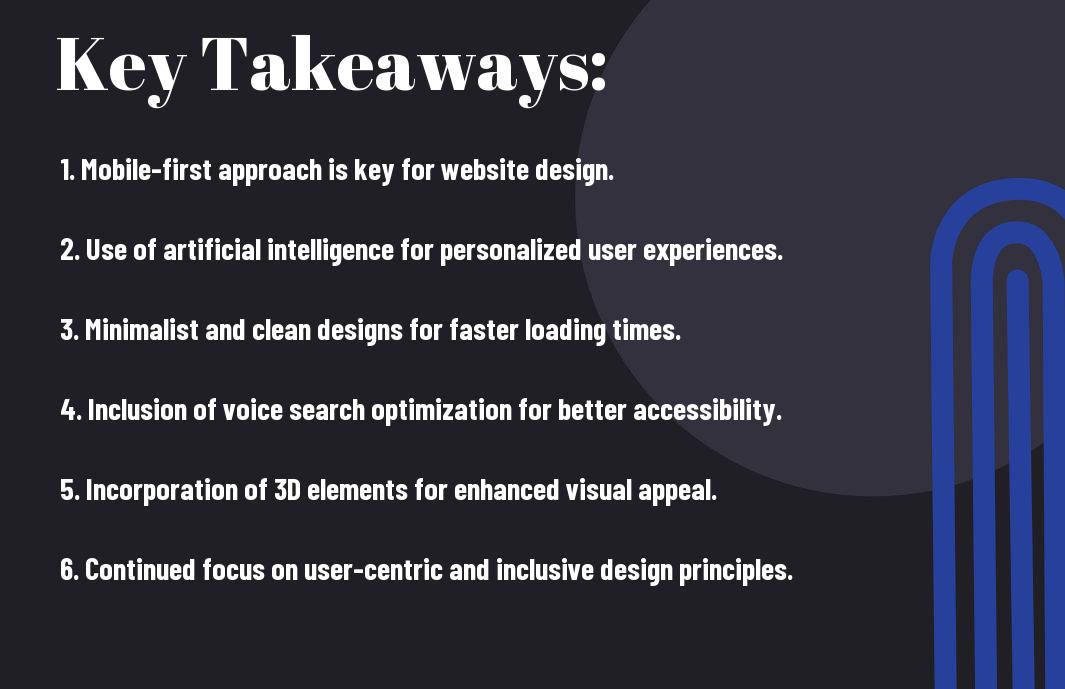Congratulations, avid internet user! As you navigate the vast sea of websites, you may have noticed that the landscape of website design is constantly evolving. In this ever-changing digital world, it’s essential for you to stay ahead of the game and adapt to the newest trends in website design. From AI integration to immersive user experiences, the future of website design is filled with exciting possibilities and potential pitfalls. In this blog post, we will explore the most important trends in website design that you should be watching out for, and how they could impact your online presence.
Key Takeaways:
- Mobile responsiveness is a crucial trend to watch, as more users are accessing websites through their mobile devices than ever before.
- Minimalistic design is becoming increasingly popular, with a focus on clean and simple layouts to enhance user experience.
- Artificial intelligence and machine learning are shaping the future of website design, with personalized user experiences and smart content curation.
- Voice search optimization is on the rise, as more users are utilizing voice commands to search for information online.
- Animation and micro-interactions are enhancing user engagement and creating more interactive and immersive experiences on websites.

The Rise of Artificial Intelligence in Design
One of the most significant trends shaping the future of website design is the increasing role of Artificial Intelligence (AI). As AI continues to advance, it is revolutionizing the way websites are created and improving the overall user experience. From automated web design tools to AI’s impact on user experience, the rise of AI in design is set to transform the industry.
Automated Web Design Tools
With the rise of AI, automated web design tools are becoming more prevalent. These tools use machine learning algorithms to analyze data and make design decisions based on user preferences and behavior. They can generate personalized content, layout, and design elements tailored to your specific audience. This streamlines the design process and allows for faster, more efficient website creation.
AI’s Impact on User Experience
AI’s impact on user experience is significant, as it has the potential to enhance personalization and interactivity on websites. By analyzing user data and behavior, AI can deliver personalized content, product recommendations, and interactive features that cater to your visitors’ preferences and needs. This improves user engagement and can lead to higher conversion rates. However, it’s important to consider the ethical implications of AI-driven personalization, as it raises concerns about data privacy and potential manipulation of user behavior.
Adaptability Across Devices
Keep in mind that the future of website design will require adaptability across various devices. Your website needs to function seamlessly whether it’s being viewed on a desktop, laptop, tablet, or smartphone. With more people accessing the internet through mobile devices than ever before, it’s crucial to ensure that your website is responsive and user-friendly on all screen sizes. To stay ahead of the curve, it’s essential to keep an eye on the latest web design trends. You can read more about this in The Most Popular Web Design Trends to Watch in 2023.
Mobile-First Design Approach
When it comes to designing a website, a mobile-first approach should be at the forefront of your strategy. This means creating a website with the mobile user experience as the primary focus, and then adapting it for larger screens. By prioritizing the mobile experience, you ensure that your website is accessible and functional for the majority of your audience. This approach also aligns with search engine algorithms that prioritize mobile-friendly websites in search results, ultimately improving your website’s visibility and user engagement.
The Emergence of Wearable Tech Compatibility
With the increasing popularity of wearable technology such as smartwatches and fitness trackers, compatibility with these devices is becoming a significant consideration in website design. As more users access websites through wearable devices, it’s crucial to optimize your website for these platforms. This may involve streamlining content, minimizing load times, and incorporating voice-activated features to enhance the user experience on wearable devices. By doing so, you can stay ahead of the curve and ensure that your website remains accessible to users across all types of devices.

Aesthetic and Visual Trends
Not only is website design evolving in terms of functionality and user experience, but it is also constantly changing in terms of aesthetics. Keeping up with the latest visual trends is crucial for your website to stay relevant and engaging for your audience.
Minimalism and White Space
One of the most prevalent aesthetic trends in website design is the use of minimalism and white space. This approach focuses on simplicity and clean design, allowing your content to stand out and be easily digestible for your visitors. Minimalist design often utilizes ample white space, which not only creates a sense of elegance and sophistication but also improves readability and user engagement.
Bold Typography and Micro-interactions
Another visual trend that has been gaining momentum is the use of bold typography and micro-interactions. Large, attention-grabbing fonts not only make a statement but also help your website to convey your brand’s personality. Additionally, incorporating micro-interactions such as animated buttons or subtle hover effects can enhance your user experience and create a more interactive and immersive design.
Advanced Interactivity and User Engagement
For a successful website, it’s crucial to focus on advanced interactivity and user engagement. This includes features that enhance the user experience and keep visitors coming back for more. Here are some trends to watch in this area:
- Voice User Interfaces (VUIs)
- Virtual Reality (VR) and Augmented Reality (AR) Integration
Voice User Interfaces (VUIs)
Voice user interfaces (VUIs) are becoming increasingly popular as users seek more hands-free and intuitive ways to interact with websites. Incorporating VUIs into your website design can significantly improve user experience by allowing visitors to control the site with their voice commands. From searching for content to navigating through pages, voice commands can make the user experience more seamless and efficient. This technology not only adds a innovative touch to your website, but also provides accessibility to those with disabilities. However, it’s important to consider privacy and security concerns when implementing VUIs, as the technology collects and processes user data through voice commands.
Virtual Reality (VR) and Augmented Reality (AR) Integration
Integrating virtual reality (VR) and augmented reality (AR) into website design can take user engagement to a whole new level. By offering immersive experiences, you can transport your visitors to virtual environments or enhance their real-world surroundings with digital overlays. This can be particularly effective for businesses in industries such as real estate, tourism, or retail, where users can engage with products and services in a more interactive and personalized way. Implementing VR and AR may require additional resources and expertise, but it can differentiate your website from the competition and leave a lasting impression on your audience. However, it’s important to ensure that the experience is seamless and optimized for various devices to provide a truly immersive and accessible experience for your users.
Ecological and Social Consciousness in Design
To stay ahead in the ever-evolving world of website design, it’s crucial for you to consider ecological and social consciousness in your designs. With the rise of environmental and societal concerns, consumers are becoming more discerning about the values and practices of the brands they engage with. You can read more about the New Design Trends To Watch For in 2024 for valuable insights on this topic.
Sustainable Design Practices
Implementing sustainable design practices is not only good for the planet but also for your brand. Your audience increasingly expects you to minimize your ecological footprint and prioritize sustainable materials and processes in your website design. Embracing sustainable practices not only demonstrates your commitment to ethical and responsible business but also resonates with environmentally conscious consumers, strengthening your brand’s reputation and appeal.
Inclusivity and Accessibility Standards
When it comes to website design, inclusivity and accessibility are paramount. Ensuring that your website is accessible to all individuals, including those with disabilities, not only broadens your audience reach but also reflects your commitment to inclusivity. By integrating accessibility standards into your design, you make your platform more user-friendly and demonstrative of your dedication to serving all individuals, irrespective of their abilities. This not only enhances the user experience but also showcases your brand as empathetic and considerate, fostering positive connections with your audience.
The Future of Website Design – Trends to Watch
With these considerations in mind, it is clear that the future of website design is rapidly evolving. By staying on top of the latest trends and technologies, you can ensure that your website remains competitive and engaging for your audience. Whether it’s implementing AI and machine learning, prioritizing mobile responsiveness, or utilizing creative and immersive user experiences, the possibilities are endless. By keeping an eye on these trends, you can position yourself as a leader in website design and create a seamless and immersive online experience for your visitors. Embracing these trends and staying ahead of the curve will ultimately set your website apart and keep your audience engaged and satisfied.
FAQ
Q: What are the current trends in website design?
A: The current trends in website design include minimalism, bold typography, immersive storytelling, mobile responsiveness, and interactive scrolling.
Q: Why is mobile responsiveness important in website design?
A: Mobile responsiveness is important in website design because of the increasing use of mobile devices for internet browsing. A website that is not mobile responsive will provide a poor user experience and may negatively impact search engine rankings.
Q: How can immersive storytelling be incorporated into website design?
A: Immersive storytelling can be incorporated into website design through the use of compelling visuals, interactive multimedia elements, and a narrative structure that engages the user and guides them through the website experience.
Q: What is the role of bold typography in modern website design?
A: Bold typography is a key design element in modern website design that helps to create visual hierarchy, draw attention to important content, and enhance the overall aesthetic of the website.
Q: How can interactive scrolling enhance the user experience on a website?
A: Interactive scrolling can enhance the user experience on a website by providing a dynamic and engaging way for users to navigate through content, discover information, and interact with the website in a more intuitive and immersive manner.
